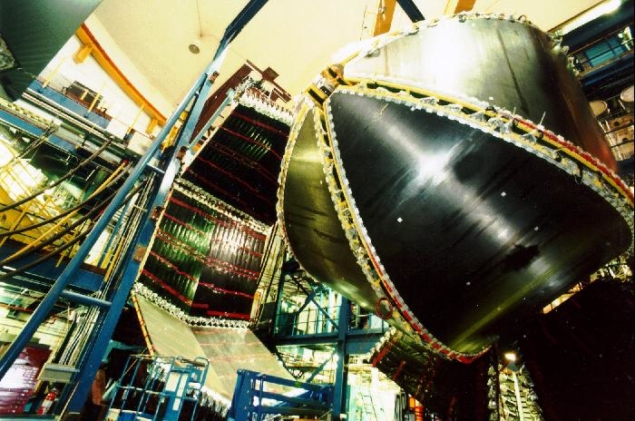
A team of researchers from the UK, Germany and the US has used data from the CLAS experiment at Jefferson Laboratory to confirm an anomalous measurement of ⍺– — a key parameter in the theoretical description of the non-leptonic decays of Λ hyperons. ⍺– describes the interference of parity-conserving and parity-violating amplitudes in the matrix element of the decay Λ → pπ–, and its Particle Data Group listing had remained unchanged for over 40 years. The new value will have consequences for heavy-ion physics, measurements of the transverse polarisation of Λ hyperons, the decays of heavier strange baryons, and kaon production.
Prior to this year, the best measurement of ⍺– was derived from π−p→ΛK0 interactions using liquid-hydrogen targets dating from the early 1970s. In May, however, the BESIII collaboration in Beijing published a new measurement ⍺– = 0.750 ± 0.009 (stat) ± 0.004 (syst) based on observations of the decays of ΛΛ pairs from electron-positron collisions at the J/ψ resonance. The collaboration also reported a measurement of the corresponding parameter ⍺+ = −0.758 ± 0.010 (stat) ± 0.007 (syst) for the charge-conjugate decay Λ → p̄π+, consistent with the conservation of CP symmetry — the most sensitive test with Λ baryons so far. The BESIII value is 17% (corresponding to more than five standard deviations) above the previously accepted value, ⍺– = 0.642 ± 0.013. “We suspect previous experiments underestimated some systematic biases in their analyses,” says BESIII spokesperson Yuan Changzheng, of the Institute for High-Energy Physics in Beijing.
David Ireland of the University of Glasgow, and colleagues at George Washington University, the University of Bonn and Forschungszentrum Jülich, have now confirmed the BESIII measurement using kaon photo-production (γp→KΛ) data from the CLAS detector, which operated from 1998 to 2012. Their analysis exploited CLAS measurements of polarisation observables that describe the decay of the recoiling Λ→ pπ– to infer the value of α– using a theoretical tool known as Fierz identities. The value found, α– = 0.721 ± 0.006 (stat) ± 0.005 (syst), is near to, but noticeably below, the BESIII value.
Any experiment that has used this value as part of their analysis should look again
David Ireland
“These data were not measured specifically to evaluate ⍺–,” said Ireland, a former spokesperson of CLAS, “but when the BES result was reported, we realised that they represented a unique opportunity to make an independent estimate of the decay parameter.” Any experiment that has used this value as part of their analysis should look again, he continued. “It would be sensible for the time being to use both the BES and CLAS results to give a range of possible systematic uncertainty.”
The new analysis confirms the BESIII result “very nicely”, concurs Yuan, given that it is based on completely different data and a different technique. “BESIII has now accumulated another 8.7 billion J/ψ events, and the same process will be analysed to
further improve the precision, both statistical and systematic.”
Further reading
DG Ireland et al. 2019 Phys. Rev. Lett. 123 182301.
BESIII Collaboration 2019 Nat. Phys. 15 631.








